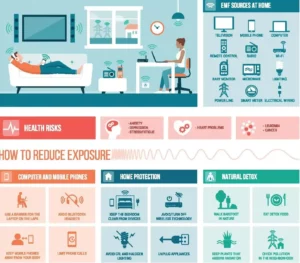Electromagnetic fields (EMFs) are increasingly becoming unavoidable in modern life. These fields are pretty much constantly emitted from smartphones, Wi-Fi routers, Bluetooth devices, and 5G networks. While much of the health conversation surrounding EMFs focuses on their potential links to cancer and neurological conditions, an overlooked area of concern is their impact on heart rate variability (HRV); this is especially freaky when considering the effects they may be having on young, healthy individuals, which is likely to apply to an equal or greater degree for less-healthy or older folks.
HRV is a critical biomarker of overall heart health, stress resilience, and autonomic nervous system balance. Recent research has suggested that EMFs may be altering HRV in subtle but concerning ways, even in people without preexisting heart conditions. This article explores how EMFs could be influencing HRV in healthy youth and what can be done to mitigate the effects.
Understanding HRV: The Heart’s Built-In Flexibility
HRV measures the variation in time between heartbeats. A higher HRV generally indicates a more adaptable and resilient autonomic nervous system, while a lower HRV is linked to chronic stress, fatigue, and an increased risk of cardiovascular disease. The autonomic nervous system, which regulates HRV, consists of two key components:
components:
- Sympathetic Nervous System (SNS): Activates the body’s “fight or flight” response, increasing heart rate.
- Parasympathetic Nervous System (PNS): Governs the “rest and digest” function, slowing heart rate and promoting recovery.
A well-balanced HRV means the heart is responding appropriately to physical and emotional stressors. But, as we mentioned, there’s some research developing that suggests that exposure to EMFs may be disrupting this balance in ways that are affecting young, healthy individuals who are expected to have an optimally functioning nervous system for peak performance in their daily lives
How EMFs May Be Impacting HRV
EMFs can interfere with the body’s natural bioelectrical signals, particularly those regulating autonomic function. Studies suggest that EMF exposure can lead to:
- Increased sympathetic activity – leading to prolonged stress responses and decreased HRV.
- Reduced parasympathetic activity – making it harder for the body to recover from stress and maintain equilibrium.
- Altered sleep quality – impacting nighttime HRV, when the body should be in a recovery state.
HRV Changes in Response to EMF Exposure
A growing number of studies indicate that EMFs may negatively affect HRV, particularly in young individuals who are frequently exposed to wireless devices:
- A study on medical students found that short-term exposure to Wi-Fi and 4G networks resulted in significant shifts in HRV, indicating an increase in sympathetic dominance.
- Occupational research on radio-frequency workers showed that prolonged EMF exposure was associated with decreased HRV, a well-known risk factor for long-term cardiovascular disease.
- Lab-controlled experiments demonstrated that exposure to EMFs can change the body’s ability to regulate heart rate, further supporting concerns about parasympathetic suppression.
While these changes may not produce immediate symptoms, they suggest that long-term exposure to EMFs could be quietly undermining the heart’s ability to self-regulate, leading to increased cardiovascular strain over time.
Why HRV Matters
The Long-Term Consequences of Reduced HRV
HRV has increasingly become a key measure of health in all age groups. High HRV is associated with better:
- Cognitive function – Higher HRV correlates with improved focus, decision-making, and stress adaptation.
- Physical performance – those with high HRV recover faster from exercise and sustain peak performance longer.
- Emotional resilience – A well-regulated nervous system improves mood stability and stress management.
If EMFs are lowering HRV, they may be setting young people up for a future of increased stress susceptibility, burnout, and even heightened cardiovascular risk later in life – they may also be hindering health for people at any age.
Constant EMF Exposure in The Modern World
Young people are often the most exposed to EMFs, but this trend is slowly spreading throughout all demographics. This is due to:
- Constant smartphone use
- Wearing wireless devices like smartwatches and earbuds
- Spending hours in Wi-Fi-heavy environments like schools, libraries, and coffee shops
- Sleeping next to phones or other electronic devices
This continuous exposure could mean that EMF-induced HRV disruptions are happening throughout the day and night, preventing the body from ever fully returning to a baseline state of relaxation and recovery.
How to Protect Your HRV from EMF Disruptions
If you’re concerned about EMFs affecting your HRV, here are some simple steps you can take:
- Keep your phone away from your body – Avoid carrying it in your pocket or sleeping with it under your pillow.
- Turn off Wi-Fi and Bluetooth at night – This can improve sleep quality and support nighttime HRV recovery.
- Use wired connections when possible – Ethernet cables offer a low-EMF alternative to Wi-Fi.
- Limit wearable tech usage – Smartwatches and wireless earbuds continuously emit EMFs close to your body.
- Practice grounding (earthing) – Spending time barefoot on natural surfaces may help counteract EMF effects.
- Incorporate stress-reduction techniques – Meditation, deep breathing, and yoga have been shown to increase HRV and may help counterbalance the effects of EMFs.
- Stay hydrated and maintain proper nutrition – Electrolyte balance is essential for nervous system regulation, which is closely tied to HRV.
Aires: A Scientifically Validated EMF Mitigation Solution
While lifestyle changes help, it’s difficult to avoid EMFs entirely in the modern world. Aires offers scientifically backed technology designed to mitigate the impact of EMFs on biological systems, including the heart and nervous system.
Unlike passive shielding products, Aires devices work by modulating and restructuring EMF waves, helping to neutralize their disruptive effects on HRV and autonomic balance. For those who want to protect their long-term heart health without abandoning modern technology, Aires offers a practical and research-supported approach.

Closing Thoughts
HRV is one of the most valuable indicators of overall health and resilience, particularly in young people who should serve as examples for peak cognitive, physical, and emotional performance. Emerging research suggests that EMFs could be quietly reducing HRV by disrupting the autonomic nervous system, leading to increased stress responses and decreased recovery potential.
While more studies are needed to fully understand the long-term impact, the existing data supports a cautious approach. Reducing direct exposure, optimizing sleep environments, incorporating stress-reduction techniques, and leveraging validated EMF mitigation solutions like Aires can help young individuals protect their HRV and maintain long-term cardiovascular health.
With modern life increasingly dependent on wireless technology, awareness and proactive steps today could make all the difference in protecting health for the future.








